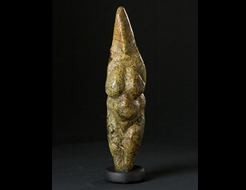|
||||||||||||||||||||||||||||||||
|
|
Museum of: Rome | |||||||||||||||||||||||||||||||
| Name of the artefact: Venus of Savignano | ||||||||||||||||||||||||||||||||
|
The so-called Savignano’s Venus is the Italian most
famous prehistoric female figurine. Carved in serpentine this figurine
shows a possible mix of symbolic value between the male and female
sphere |
||||||||||||||||||||||||||||||||
|
WHERE IS IT AND MAIN
CHARACTERISTICS |
STATE |
|||||||||||||||||||||||||||||||
|
Department: |
- |
Preservation: |
Very good | |||||||||||||||||||||||||||||
|
Inventory number: |
108610 |
Restauration: |
No restored | |||||||||||||||||||||||||||||
|
Name of the artefact: |
Venus of Savignano |
Completeness: |
Complete | |||||||||||||||||||||||||||||
|
Object type: |
Human figurine |
|||||||||||||||||||||||||||||||
|
Material: |
Steatite |
|||||||||||||||||||||||||||||||
|
Methof of manufacture: |
Carved and smoothed stone |
|||||||||||||||||||||||||||||||
|
Decoration
type: |
Incision |
|||||||||||||||||||||||||||||||
|
Distinctive mark: |
- |
|||||||||||||||||||||||||||||||
|
DIMENSIONS |
PERIOD OF USE |
|||||||||||||||||||||||||||||||
|
Length (mm): |
- |
Epoque: |
Paleolithic |
|||||||||||||||||||||||||||||
|
Heigth
(mm): |
225 |
Culture: |
Gravettian - Epigravettian |
|||||||||||||||||||||||||||||
|
Diameter
(mm): |
- |
Period: |
Late Paleolithic Period |
|||||||||||||||||||||||||||||
|
Width (mm): |
48 |
Face: |
- |
|||||||||||||||||||||||||||||
|
Thickness (mm): |
52 (thickness pubic area ) |
Absolute chronology: |
18000-10000 BP |
|||||||||||||||||||||||||||||
|
Weight
(g): |
- |
|||||||||||||||||||||||||||||||
DISCOVERY |
||||||||||||||||||||||||||||||||
|
Date: |
1923 |
Country: |
Italy |
|||||||||||||||||||||||||||||
|
District: |
Emilia-Romagna |
Town hall affiliation: |
Modena |
|||||||||||||||||||||||||||||
|
Village: |
Savignano |
Discovery findspot: |
- |
|||||||||||||||||||||||||||||
|
Condition of discovery: |
Chance Discovery |
Discovery type: |
Deposit |
|||||||||||||||||||||||||||||
|
ANALYSES – DETERMINATIONS |
FILLED IN BY |
|||||||||||||||||||||||||||||||
|
Type: |
- |
Name: |
Chiara Delpino, Vincenzo Tinè |
|||||||||||||||||||||||||||||
|
Laboratory: |
- |
Institution: |
- |
|||||||||||||||||||||||||||||
|
No./Code: |
- |
Date: |
10-2005 |
|||||||||||||||||||||||||||||
|
DEEPENINGS |
||||||||||||||||||||||||||||||||
|
Morphology of the object: |
||||||||||||||||||||||||||||||||
|
The figurine was carved out of a tender block of
yellow-greenish serpentine stone block, in order to be viewed from all
four sides. The statuette can be inscribed within a diamond shape with the
torso in the center and the extremities ending in conical shape. The head
is roughly carved in a conical shaped pyramid with a smoothed corned which
can be interpreted as the two sides of the face. The shoulders are barely
shown, the arms are carved in detail while the forearms, roughly carved
and missing the hands, are reclined as to hold up the large breast. The
bust is slightly tilted backwards and the back is slightly convex: the
stomach is large and presents a lateral line along the loins. The buttocks
are pronounced and separated by a deep carved line, the thighs are
voluminous. On both sides the legs are divided by a vertical carved line
more pronounced on the back side where it connects with the carving
demarking the buttocks. The short legs end in a conical shape without
details of the feet. Slightly convex shaped marks seem to define the
knees. The figurine is not free-standing but thanks to a flat area at the
center of the buttocks can be places supinated or seated. |
||||||||||||||||||||||||||||||||
|
Decoration: |
||||||||||||||||||||||||||||||||
|
On the front left side of the head, on the right arm
and lower backside of the figurine are visible traces of red color,
possibly ochre. |
||||||||||||||||||||||||||||||||
|
Inscription: |
||||||||||||||||||||||||||||||||
|
- |
||||||||||||||||||||||||||||||||
|
Analogies: |
||||||||||||||||||||||||||||||||
|
Female figurines dating back to the Gravettian and/or
Epigravettian period have been found in Italy in the Caves of Balizi Rossi
of Grimaldi in Liguria, around the Lake Trasimeno in Umbria and in the
cave of Venus near Parabita in Apulia. All of these statuettes were
recovered within uncertain archaeological stratigraphies but it was
possible to date them back to the Upper Paleolithic Period thanks to the
strong analogies with the “Venus” of the European Gravettian Period.
Certain stylistic aspects of the Venus of Savignano, larger in size, more
elongated in shape and less obese compared to the European artefacts,
makes it impossible to formulate valid comparisons. |
||||||||||||||||||||||||||||||||
|
Interpretation: |
||||||||||||||||||||||||||||||||
|
The shape of the stomach, the abundance of the breast
and the roundness of the hips and the buttocks suggests a pregnant female
figurine. Different hypothesis have been suggested regarding the position
of the statuette: some scholars believe that the “Venus” was vertically
planted in the ground based on the fact that the lower part of the body is
a worse condition compared to the upper one. This idea seems unlikely
because of the fine carving present in the line dividing the figurine’s
legs nearly to the extremity which suggests that the whole statuette was
meant to be seen. Other scholars have suggested that the “Venus” was lying
on its back with the torso and buttocks touching the ground. The position
of the breast and stomach however do not suggests a supine female woman.
Lately a new hypothesis has been made of the figurine as the depiction of
a seated woman with her back slightly tilted backwards. The “Venus of
Savignano” was found by chance during construction work at a depth of 1.4
– 2 m., within a fluvial area from the Upper Pleistocene Period. At the
time the layer in which the figure was recovered was described as
“unaltered clay and yellowish” alluvial soil. Recent investigation in the
area has attested that the loess layer in which the “Venus” was recovered
covers an alluvial conoide of the Panaro River from 30000 years ago.
Because the artefact was not recovered in a specific archaeological
context it has been attributed to different chronological phases. On the
base of a stylistic analysis of the figurine most scholars date it back to
the Upper Paleolithic Period, but since its recovery (Antonelli 1925 e
1926) and more recently (Fugazzola 2001) a Neolithic Period attribution
has been suggested. |
||||||||||||||||||||||||||||||||
|
Bibliography: |
||||||||||||||||||||||||||||||||
|
ANTONIELLI U., 1925, Una statuetta femminile di
Savignano sul Panaro e il problema delle figure dette “steatopigie”, in
BPI, XLV, pp.35-61 ANTONIELLI U., 1926, La statuetta femminile
steatopigica di Savignano sul Panaro, in RivAntr XXXVII, pp.283-299
ANTONIELLI U., 1928, A proposito della “Veneretta” di Svignano (commenti
alle critiche), BPI, 48, pp..140-156 ARNOLDUS-HUYZENDVELD A., 1996:
"Contexte pédologique", in: M.Mussi: "Problèmes réecents et découvertes
anciennes: la statuette de Savignano" in: Bulletin de la Société
Préhistorique. FORMENTINI R., Le “Veneri”: immagini femminili tangibili.
Figure e segni nella pietra. Preistoria Alpina, 2, pp.164-170 FUGAZZOLA
DELPINO M.A., 2001, in Donne, uomini, animali, arte e di culto nella
preistori. Catalogo della Mostra GRAZIOSI P., 1973, L’arte preistorica in
Italia, MUSSI M., ZAMPETTI D., 1988, Frontiera e confini del Gravettiano,
Scienze dell’Antichità, 2, pp.46-78 PALMA DI CESNOLA A., 1993, Il
Paleolitico Superiore in Italia, Firenze. |
||||||||||||||||||||||||||||||||

